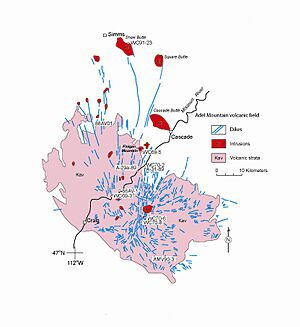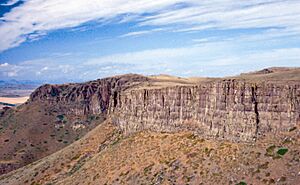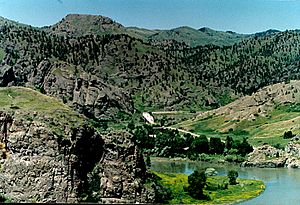Adel Mountains Volcanic Field facts for kids
The Adel Mountains Volcanic Field is an ancient area of volcanic rocks in west-central Montana. These rocks are about 75 million years old and cover a large area, roughly 40 miles long and 20 miles wide. That's about 800 square miles! It's located about 30 miles southwest of the city of Great Falls.
A geologist named John Bartholomew Lyons first described this area in 1944. The Adel Mountains Volcanic Field is special because it has a lot of shonkinite. This is a very rare type of volcanic rock mostly found in Montana, Ontario, and Timor. Because of its unique rock formations, geologists have been interested in the Adel Mountains Volcanic Field for over 100 years.
What It Looks Like
The Adel Mountains Volcanic Field has a thick layer of rock, about 3,280 feet deep. This layer sits on top of older Cretaceous sedimentary rocks. The rocks that erupted from volcanoes (called extrusive rocks) are made of breccia (rock with sharp, broken pieces) and conglomerate (rock with rounded pieces).
The rocks that formed inside the Earth (called intrusive rocks) created many interesting shapes:
- Dikes: These are like giant walls of rock that cut through other rock layers. Many dikes here spread out like spokes from the center of the area. You can even see some of these striking, vertical dikes from the highway!
- Sills: These are flat sheets of rock that squeeze between other rock layers.
- Plugs: These are the hardened cores of ancient volcanoes, like a cork in a bottle.
- Laccoliths: These are dome-shaped rock formations. They form when magma pushes up the layers of rock above it, creating a bulge.
Some famous local landmarks are laccoliths from the Adel field. These include Square Butte, Shaw Butte (near Ft. Shaw), and Cascade Butte (next to Cascade). Square Butte, for example, used to have over 2,000 feet of rock on top of it, but erosion has worn it away, showing the volcanic rock underneath.
Adel Mountain is the tallest peak in this volcanic field, standing at 7,093 feet above sea level. Another unnamed peak is the second highest at 6,845 feet.
How It Formed
Scientists have studied the age of the Adel Mountain Volcanic Field many times. In 1944, based on fossils, it was thought to be about 66 million years old. Later studies in the 1990s and 2000s found it was actually formed between 81 and 71 million years ago. Today, most scientists agree it's about 75 million years old.
The Adel volcanics are part of the Laramide orogeny. This was a long period of mountain building in western North America that started about 80 million years ago. During this time, melted rock (magma) pushed up from deep inside the Earth for millions of years. This magma created the Adel volcanics, as well as the nearby Highwood Mountains and Judith Mountains.
A weak spot in Earth's crust, called the Great Falls Tectonic Zone, might have helped the magma reach the surface. Even the magma that didn't erupt still formed the many dikes, sills, plugs, and laccoliths we see today in the Adel volcanic field.
Scientists have also looked into whether there might be petroleum (oil) or hydrocarbons (natural gas) under the field. They think there's a good chance these resources exist there.
In Popular Culture
The Adel Mountains Volcanic Field has appeared in movies and TV shows:
- The end scenes of the 1974 movie Thunderbolt and Lightfoot were filmed near Interstate 15 as it goes through the Adel volcanics.
- Part of the 1987 movie The Untouchables was shot at the Hardy Bridge in the Adel Mountains Volcanic Field. The bridge was used to look like the U.S.-Canada border in the film.
- The famous movie star Gary Cooper grew up on the Seven Bar Nine Ranch, which was located in the Adel Mountains.
- The eruption that created the Adel Mountains Volcanic Field is shown in an episode of the American TV series Dinosaur Planet.




